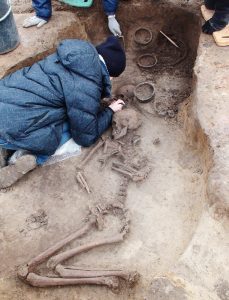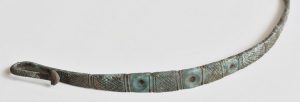Archaeologists uncovered skeletal and cremation burials dating to 1st Cent. BC – 1st Cent. AD in Wierzbiczany, North Poland. The site is believed to be a component of a network of sites associated with a transregional settlement complex of Germanic tribes.

The archaeologists from University of Warsaw believe the site to be central place of an important Iron Age complex, that served as a settlement, a centre for crafts, trade, social and political life. The complex is believed to consist of a few vast adjacent open settlements and corresponding cemeteries. Most of such sites from the era are known from Scandinavia, such as Sorte Muld on Bornholm. The one found in Wierzbiczany and nearby Gąski is the first such find from the area of Poland. Archaeologists started their fieldwork in early 2017, initially unearthing a previously unknown Prehistoric settlement and a nearby cemetery, which was being destroyed by ploughing. Among the finds were pieces of jewellery, including ones made in Celtic and Roman workshops. The cemetery contained both crematory and skeletal burials, which considered very special by the archaeologist led by Marcin Rudnicki. The usual burial custom for the East-Germanic Przeworsk Culture group, associated with the inhabitants of the site was cremation. On the other hand skeletal burials were discovered in smaller numbers, located on the outskirts of the cremation burial cluster. It is believed that the skeletal burials indicate the presence of a foreign ethnic group, which might correspond through the burial customs of the people inhabiting the area between Lower Vistula and Czech and Slovakia.

It is believed that the cemetery functioned during the turn of eras and contained burials in which unique goods were places along the remains of the deceased. One skeletal burial contained two individuals, possibly women, placed one on top of the other. Both were equipped in separate sets of grave goods. One of the discovered artefacts was a bronze belt buckle, typical for North Germanic tribes. Other grave contained a skeleton of an adult and a child burial, placed on its side, dug into it. Among the grave goods discovered at the site are also numerous beads, including amber ones, and fibulae imported from Northern Italy and Noricum. A unique find was a bronze bucket, called a situla, made in Northern Italy or East Alpine region. It was used as a cremation urn, as the burned remains of a high status individual together with grave goods were placed inside. The artefacts date the object to the reign of Octavian Augustus – 27 BC-14 AD. The situla awaits x-ray photography and careful archaeological investigation.

Archaeologists will continue the excavations this year. They want to uncover a larger portion of the necropolis in order to determine whether it functioned beyond the established time-frame, and why did it became unused. The settlement complex existed in later times, during the times of the Roman Empire. Between 1st-5th cent. AD large numbers of coins, pottery, jewellery, and ornaments were imported there. So far archaeologists also discovered a few thousand of Roman coins in Wierzbiczany and Gąski, which – according to Marcin Rudnicki – indicate the unique status and importance of the site.
(after Marcin Rudnicki & Uniwersytet Warszawski)